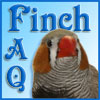|
CARE
TOPICS
|
||
|
C |
Diet
|
|
|
Nail
Trimming |
|
Nail Clipping *** New - Video of Nail Trimming ( Windows Media / Real Audio ) *** Nail clipping is sometimes necessary. How often depends on the type of finch. My zebra finches hardly ever need their nails trimmed. Society finches and owls need them trimmed occasionally. Waxbills, like strawberry finches and orange cheeks need them trimmed frequently, or they will become very long and quite dangerous. I once took in a female strawberry finch from a pet store. Her nails were so long, the back nail curled in a spiral. It was grey, and when I trimmed it, it was obvious that it no longer had a live blood supply and had become a "dead" nail. If you don't clip nails and they need it, the bird could become caught - on a perch, a nestbox, a rope fiber, nesting material, or anything else that a long nail could hook itself around. A bird whose nail is caught could end up dangling upside down - if he cannot extricate himself, he could die. A bird could also become injured trying to free himself. If the injury results in blood loss, it could be fatal. Therefore, nail-trimming should not be put off.
To me, the hardest part about trimming nails is catching the bird in question (see Catching Birds in an Aviary). Once caught, a regular nail clipper can be used to trim off the excess portion of the nail. I try to trim as close to the quick (the blood supply within the toenail) as possible, without cutting it. This is easier with species that have light colored toenails. With other species, you just have to guess (I error on the side of a little too long). A good article with nice pictures by Kathy Dezern can be found on her website, FinchFancier.com. (It appears this website no longer exists or has moved. The article, however, has been reprinted with permission at Salem's Java Finches.) She also explains how to cauterize the nail, should you accidentally cut into the quick. I keep blood stop powder on hand in case I ever make this mistake. Blood stop powder is available from Birds2Grow. As the article indicates, a better method for stopping blood flow is cauterization. I have used both blood stop powder and cauterization with a match tip with great success. It rarely is needed, but when it is, both methods have been effective and I have never lost a bird trimming its nails. ***
NEW - 8/21/2006 *** Sometimes it is helpful to see something done, so I made the following video of me clipping the nails of an orange-cheeked waxbill. This bird had managed to sneak by without a clipping in a while and his nails were quite long. Because his nails are dark in places, I cannot always see the quick, so I have to make a judgment call. I cut this bird's nails conservatively - I could have gotten a bit closer in a few places. The video is not as crisp as I would like because my point and shoot camera cannot focus well at extremely close distances and because I was trying to both run the camera and cut the bird's nails at the same time - a tricky feat. However, the video is clear enough to serve its purpose. (Note that on the second foot, there is a strange extension of the back nail - it looked like the nail had started to break because it had been allowed to grow too long.)
|
HOME | CONSTRUCTION
| CARE | BIRDS
| ACCESSORIES | BACKGROUND
AVICAM | GALLERY
| GUESTBOOK | LINKS
| SEARCH
SITE MAP | DISCLAIMER
| CONTACT US
(c)2005 FinchAviary.com




